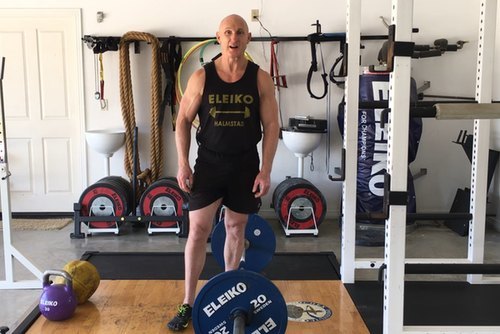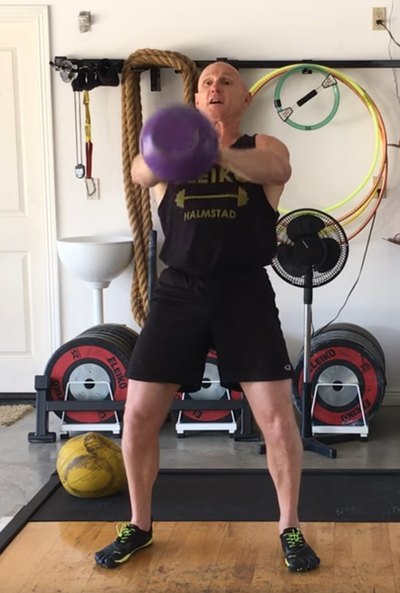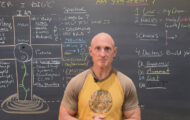The Pivot Shift
Happy Monday to you all. After my long series on the Seven A’s of Healing, I thought I’d shift the focus to something a bit more physical for you.
In this week’s vlog, I’ll talk about the pivot shift, a simple but very, very important concept I rarely ever see being taught by exercise professionals or strength coaches.
The pivot shift has to do with balancing the inertia of a weight that you’re swinging, lifting or moving, as well as the changes in your center of gravity created by the movement of the load, and the use of the mass and the mechanics of your own body.
In my vlog, I’ll show you how the pivot shift works by using this technique with a kettlebell swing, medicine ball toss, the squat and deadlift.

If you don’t use the pivot shift when you’re swinging a kettlebell, for example, you’ll tend to lean forward onto your feet, especially in the lower position. That leads to a lot of leg activity and excessive back activity which creates a lot of inefficiencies.
Just to remind you, training with weights, especially for sports conditioning, is way different than bodybuilding. How? In bodybuilding, the goal is to isolate specific muscles and force the load through that tissue to trigger breakdowns in order to stimulate hypertrophy.
Over my career, I’ve trained countless elite athletes who have suffered a loss of performance because they used bodybuilding techniques. As a result, they became biomechanically inefficient and over-reliant on muscular force.
Remember, there is a natural mechanism built into our bodies to produce efficiency. Eons ago, food wasn’t always readily available, so we learned through interacting with our environment and our own survival instincts how to become more biomechanically efficient.
Swinging away

When I’m swinging that 20-kilogram/44-pound kettlebell, you’ll see in my vlog that it’s accelerating away from me. The faster it goes, the more force it generates against me. So, instead of using my legs and arms to fight back as the load is accelerating, I’m pivoting from my hip joint.
How I’m moving also has to do with where my center of gravity is situated. If the center of gravity of the weight is below my belly button and my center of gravity is pulling it down as the weight is going forward, my center of gravity is moving up and forward with the weight and pulling me forward.
If, as the weight is swinging, I can pivot against the weight and use the weight of my own body as a counterbalance, I can create an axis of rotation through my hips. That allows me to use minimal muscular effort and achieve maximum efficiency.
What ends up happening are two things:
- You can lift more weight for the same number of reps because you’re burning off less unnecessary energy and can be more mechanically efficient.
- You can get more reps per set or workout, so the total volume of training is higher, which means you’re getting more effective neural programming in the motor system.
Remember, repetition is the mother of skill, provided there is skill in the repetition. My wife, Penny, says perfect practice makes perfect.
If you’re just trying to blast the hell out of yourself strictly to make more muscle then these things aren’t so important, except for the fact that you can become injured far more easily because your biomechanics aren’t ideal.
When you do the pivot shift, it should have a nice, efficient feel to it, almost as if you’re in a rocking chair and effortlessly rocking versus trying to muscle it.
The pivot shift also gives you much better awareness of body mechanics and enhances athletic performance too. Using it can increase the distance of a medicine ball toss by as much as 10 feet. For kettlebell lifters, it’ll extend how many reps you can do in any given set with a clean and jerk or a kettlebell swing.
In fact, it’s a great technique that re-enforces optimal neural programming and trains the body to work the way Mother Nature would have wanted to increase our durability and survival.
Resources
If you want to learn more about techniques like the pivot shift, you may want to consider my Gym Instructor DVD video series that features core conditioning techniques and recommendations on how to perform pushing and rowing exercises, along with rows, pulls, chins and deadlifts safely and efficiently.
You’ll also discover a lot of great tips in the brand new second edition of my book, How to Eat, Move and Be Healthy!, too.
And, if you want to learn even more, you’re always welcome to join us for CHEK Exercise Coach training.
Just because the holidays are here doesn’t mean the blogs and videos stop either…
See you next week!
Love and chi,
Paul














Find me on the web